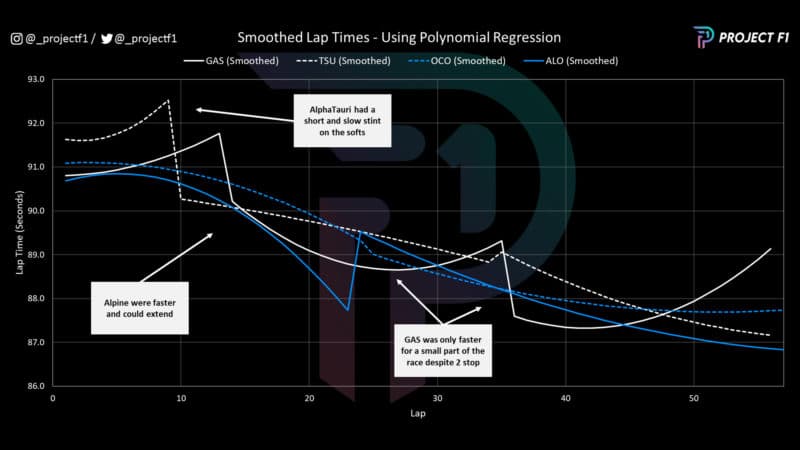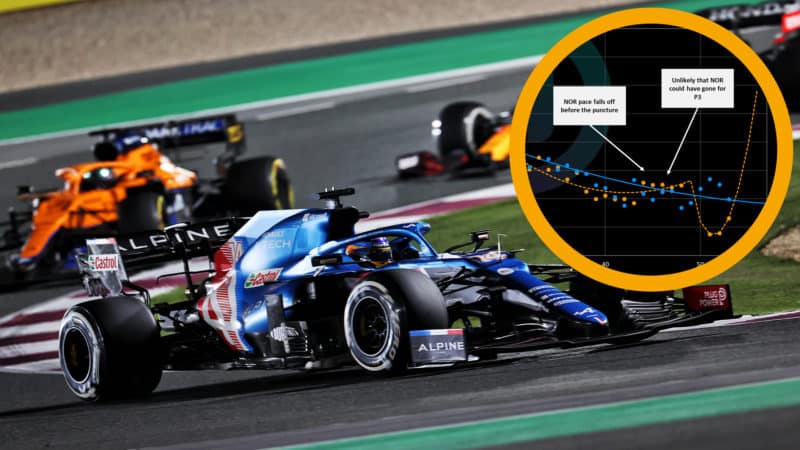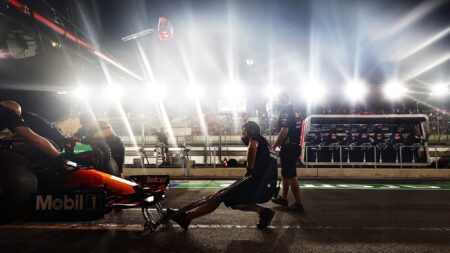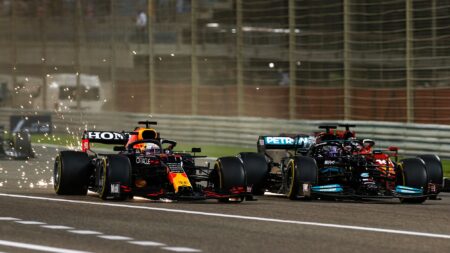Stuck behind the Spaniard, Gasly was pushing the tyres more than ideally necessary and it prompted the decision from the team to switch his strategy to a two-stop race early on.
Red Bull was also moved into the two-stopper with Perez as it tried to manoeuvre the strategy pieces to secure a podium from 11th on the grid.
Alpine meanwhile stuck to its guns, stretching the first stint to lap 19 versus Gasly’s very early switch on lap 13. Despite the one-stop pace, Alonso’s lap time continued to decrease.
AlphaTauri also opted to stop Yuki Tsunoda very early. In fact, the Japanese driver was the first driver to stop on lap 9 for fresh mediums, such was the team’s struggles to work the soft tyres effectively during the first stint.
Esteban Ocon mirrored his team-mate’s strategy and stopped one lap later than Alonso on lap 24, both swapping to the hard tyre.
Through the second stint, both Alpine drivers displayed pace comfortably faster than either AlphaTauri driver could manage as shown in the lines marking Gasly and Tsunoda on the graph below fall away.
Also clear below is how Ocon’s early pace in the second stint was a shade off of Gasly, but only briefly. Ocon steadily homed in on his P5 finish while Gasly’s pace faded once more.

This chart shows the lap times trend race pace calculated by fitting a polynomial regression to the lap times. This helps by removing slow lap times based on in and out laps for pitstops as well as those affected by safety cars or prolonged yellow flags.
Instantly evident is AlphaTauri’s weaker race pace that hurt its strategy while both Ocon and Alonso made hay and were able to extend the first stint.
Both Alpines took much better care of the tyres, placing their rubber under less stress which paid most dividends at the end of the first phase of the race.
With Alpine able to extend to beyond lap 20, it opened up the possibility to run to the one-stop window which it took full advantage of.
Gasly’s earlier stop provided him with a pace advantage for just a handful of laps over Alpine yet once again, AlphaTauri’s chewing through the tyres would cost it in the second stints.
Following the pit stops, Alonso re-established Alpine’s performance advantage and comfortably gapped the lead AlphaTauri driver.
The Italian team’s performance did improve as the track rubbered in and fuel burned off in the middle phase of the race but by that point, it was too late and Alpine held the advantage.
But what of the others?

Looking at the above graphs, Alonso’s speed in the initial phase of the race was too great for Lando Norris to keep up with the Alpine.
Despite the McLaren driver’s thoughts on the matter post-race, his pace fell away prior to the puncture derailing his night as evidenced above. Alonso looked to have that threat covered off.
But what about Perez? The Red Bull driver made a second stop on lap 41 following Bottas’s blowout and was forced to overtake Ocon.
He was fortunate to have Norris fall out of contention with a puncture of his own but would he have made it to Alonso before the end?

Perez’s speed is evident above. Even as he carved through the field to recover from the lower end of the top 10, he was making good time on those ahead.
Bottas was the other top driver to find himself embedded back in the pack but couldn’t cut through the traffic in the same way, underlining how well Perez was making gains.
The trend pace for the Red Bull driver indicates he may well have been able to extend his first stint and gain improved track position when he filtered out following the stop.





